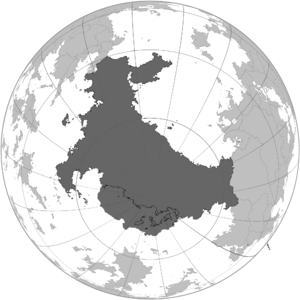Hergom ep swekorwos
| Hergom ep Swekorwos Hergom ep Swekorwos | |
| Flag | Coat of arms |
|---|---|

|

|
| Motto: "At the world's very edge, where horizons meet the sky, We rise for our last stand, as the stars bear witness on high. Blood heralds our era, as old tales are undone, For an everlasting dominion, that shall eclipse even the sun." | |
| Anthem: | |
| Locator map | |

| |
| Capital city | sample_city |
| Largest city | Ombhrosdhom |
| Official language | Wolgos language |
| Other languages | Chala |
| Ethnic group | |
| Religion | 53% Dlroch'veldr
15% Nara Akchacknism 15% indigenous beliefs 13% Venara Akchacknism 4% Neo-Shuocian |
| Demonym(s) | Herg |
| Government | |
| Government Type | Unitary Tribal Federation |
| Your 1st leader title (e.g. King) | President Name |
| Your 2nd leader title (e.g. Prime minister) | Vice President Name |
| Legislature | Congress |
| Establishment | |
| Area | |
| Total | 33,082,896.19 km2 |
| Water % | 4.66% |
| Population | |
| Total | 257,345,233 |
| Density | 7.78/km2 |
| Economy | |
| Economy type | Capitalist |
| Currency | Uhum () |
| Development index | 0.920 |
| Other information | |
| Time zone | All time zones |
| Driving side | Left |
| Calling code | +09999 |
| Internet code | -X00900 |
The premier Wolgos nation in Gotha, known as Hergom ep Swerkorwos, is situated in the deep south of the planet. It encompasses the entire region of Kupeya (called Khrupeva by the Wolgos), which includes the South pole, as well as the southernmost part of Tzeraka (called Therakha by the Wolgos). The nation recently celebrated its centenary anniversary, marking the foundation of the state after the dissolution of the Bind and Dhownolgos. Its establishment followed the conclusion of the Pan Oceanic War and the subsequent Second Great Wolgos Trek.
Despite its extensive land area, Hergom ep Swerkorwos primarily experiences challenging climates. Only around fifteen percent of its territory enjoys a temperate climate, while the remaining land is divided into alpine, taiga, tundra, and varying degrees of harsh arctic climates.
The governance of Hergom ep Swerkorwos departs from the monastic and theocratic systems of its predecessors. Instead, the nation is administered by a federated cabal of Wolgos tribes. While tribes often dominate significant stretches of territory, no Weikosa (region) is monopolized by any particular tribe. Tribes are recognized as legal entities with extraterritorial authority, representing the Wolgos and their human subjects. They encompass numerous clans and families, providing economic, legal, and welfare support.
The state does not provide comprehensive welfare services. Instead, the responsibility for healthcare, education, legal aid, security, and economic assistance lies with the tribes. The level of services varies among tribes and is often tied to their economic influence. Wolgos tribe members frequently work in their respective tribes' expansive enterprises or establish businesses associated with their tribe. However, it is not uncommon to find Wolgos working for tribes other than their own, effectively becoming adoptive members of the tribe they collaborate with.
Cities in Hergom ep Swerkorwos are vibrant hubs where diverse tribes cooperate to conduct efficient business. However, conflicts and hostile competition can arise. The government serves as a pseudo tribe composed of representatives from all tribes, working to harmonize relations and maintain a regulatory and legal framework that supports efficient industry and business operations throughout the nation.
While tribes handle most internal affairs, the government retains control over defense, monetary policy, currency minting, the legal system, relief efforts, intelligence operations, and foreign policy. Defense, infrastructure investments, and intelligence comprise the largest government expenditures. To fund its operations, the government imposes a percentage of revenue and various taxes and fees on the tribes for the services it provides.
As part of its foreign policy, the government exercises control over a number of sorikwentom (corporations and associations). Some of these entities are known to oversee twenty-seven major criminal networks across Gotha. These corporations engage in illicit activities such as distributing drugs, arms manufactured in Hergom, and a range of other illegal operations. The significant profits generated from these activities contribute to Hergom's foreign currency reserves.
Etymology
"Hergom ep Swekorwos" can be interpreted as "Enduring Strength at the World's End" or "Resilient Power at the Edge of the World." It conveys the idea of a powerful and enduring Wolgos nation located in a remote and distant region.
7598 - 7603 Wolgos Scourge (20's to early 30's tech leap) 7603 - 7620 Second Wolgos Trek 7608 Foundation of hergom
History
- See also: Dhonowlgos
- See also: The Bind
- Main article: History of Hergom
Pre-Wolgos History
Kupeya's history is marked by limited development due to its harsh environment. The northern coast had temperate land, but the variable climate rendered the colder interior inhospitable. Modest Chalam princedoms emerged along the coast, subsisting on farming and trade with the Raian archipelago. Inland, there were hunter-gatherer villages and trading communities by rivers. The advanced Phula and Alutean peninsula had stone temples and fortified villages. Alutea's progress stood out due to Ithrien's colonial influence. Kupeya's isolation was shaped by its polar proximity and the Raian archipelago, known for its rainforests, trade, and piracy. Despite bordering Kupeya, dense rainforests deterred colonization unlike neighboring regions.
7603 - 7620 - Second Wolgos Trek

After the Wolgos Scourge, Kupeya underwent a significant transformation known as the Second Wolgos Trek. The Peleykros peninsula became a hub for Wolgos migrants, reshaping the region.
Following the devastation, the Bind navy orchestrated a massive migration, relocating people and machinery from Altaia. They collaborated with Kamura and others, despite facing financial ruin. The arrival of the first Wolgos on Kupeya's shores left a handprint emblem, now on the nation's flag, commemorating the event.
Around forty million Wolgos and three million Shriaav were transported from Altaia to Kupeya over fifteen years, a complex logistical operation. However, eight million Wolgos remained in Altaia, and two million dispersed across the Shangti region, May of whom have migrated to Hergom in the subsequent decades.
Initially, challenges arose in Kupeya due to clashes with locals and limited resources. Import reliance decreased, pushing the Wolgos to adapt. The Wodranis river plains became pivotal, providing sustenance through native wildlife and the use of the indigenous population as food.
Infrastructure developed, with fishing ports and docks along rivers established by the remaining Bind administration. These developments supported settlements and resource transportation to Ombhrosdhom, evolving into a thriving city during Kupeya's transformation.
7608 Foundation of Hergom ep Swekorwos
7632 - 7634 First Coalition War
7663 - 7664 Second Coalition War
7664 - First use of nuclear weapons in Ephesus Front by the Coalition
7664 - End of the Second coalition war
7665 - Establishment of the Tzeraka demarcation border
7672 - First Wolgos nuclear Test
7681 - Non-Proliferation Treaty
7689 - Current Era
Geography
Hergom, a sprawling behemoth on Gotha, holds the distinction of being the largest nation, with an impressive expanse spanning over 30 million square kilometres. Its sheer size alone commands attention, yet this vast dominion is an array of contrasting landscapes.
The Kupeyan coast in the north serves as a verdant oasis within Hergom's otherwise challenging terrain. It is in these lands that the nation's most productive biomes flourish, offering respite from the inhospitable surroundings. Here, amidst the temperate embrace, boral forests, oceanic realms, and subtropical zones coexist, yielding an abundant harvest of grains, meats, and an array of fruits. These lush heartlands are the lifeblood of Hergom, sustaining its population and driving its economy.
In the tzerakan territories, one encounters a starkly different environment, characterized primarily by boreal landscapes. Despite the harsh climate, Hergom has defied the odds, successfully establishing livestock farms and cultivating hardy crops. This tenacity is a testament to the indomitable spirit of Hergom's people, who have harnessed even the harshest of northern realms.
Hergom's dominion extends all the way to the planet's southern pole, where an immense icecap blankets the region. Hergom has established thriving colonies on the numerous islands and rugged mountain ranges that anchor this icy expanse. Here, specialized settlements thrive, dedicated to mining and military operations, ensuring Hergom's strategic presence in this frigid frontier.
In the extreme north of Kupeya, particularly in Alutea, thin coastal bands reveal a surprising tropical contrast. Here, tropical savannahs and wet climates create a niche haven, providing Hergom with an unexpected bounty of tropical produce. Coffee, bananas, and pineapples flourish there, adding a touch of exoticism to Hergom's diverse harvest.
Government
- Main article: Government of Hergom
- See also: Wolgos political theory
Hergom ep Swekorwos stands as a distinctive nation, distinct from the theocratic traditions of old Dhownolgos and the monastic military dictatorship of the Bind. During the first years of settlement on kupeya, power shifted away from a Hlrike monopoly, and the traditional Wolgos tribal identity gained empowerment. This transformation was driven by the necessity for tribes to practice autonomy in the early years, characterized by scarce infrastructure and effective administration. As a result, Hergom evolved into a state ruled as a corporate entity with a council comprising tribal representatives and the Hlrike in an advisory capacity. However, it remains an autocratic state with a highly competitive meritocracy at its core.
At the heart of this government structure lies the Gweḱwōntiyo Hregwes, the Tribal Council, wielding all power, and the coveted position of Heghnom Kawisoos, the State Director.
The Gweḱwōntiyo Hregwes, known as the Tribal Council, stands as Hergom's exclusive legislative body, defining Hergom as a unicameral legislature. Within this structure, the Hregwis Wl̥kwos, or Council Wolves, emerge as vital figures, representing not only their respective tribes but also acting as advocates for the entirety of Hergom's citizenry. Though Hergom's populace exceeds two hundred and a half million, their interests find voice through the ninety-six Wl̥kwos, resulting in three representatives per tribe. While tribes exhibit comparable sizes, smaller ones possess a somewhat disproportionate but essential overrepresentation. These Wl̥kwos, often the tribal leaders, are designated by their tribes, serving as conduits of collective voices. Each Wl̥kwos is tasked with appointing a Dhegwhom Xḱtis, or forum office, reinforced by secretaries to facilitate communication between tribe members and their representatives. Beyond this, the forum offices are equipped with dedicated bureaus overseeing the intricate affairs of the tribe's individual clans.
The Heghnom Kawisoos, State Director, holds tremendous authority and is the pinnacle of ambition for many Wolgos individuals. The path to this position is fiercely competitive, requiring mastery of negotiation, manipulation, statecraft, and subterfuge. While the State Director holds a lifelong position, it is common for them to be deposed after a few years or decades, allowing for the ascension of more dynamic Wolgos leaders. A deposition is not considered shameful, but rather an opportunity for retirement and respite.
The tribes and their member clans play a vital role in maintaining the stability of the state and the well-being of individual Wolgos. Each tribe holds a designated geographical area of influence, aligning roughly with a Weikosa, or province. Within their respective Weikosas, tribes wield considerable influence, although it is not uncommon for different tribes to share influence and hold economic interests in each other's territories. Cooperation and harmonious coexistence are prevalent, with tribes frequently sharing settlements, towns, and cities. This spirit of collaboration extends to industry and commerce, although larger businesses tend to be dominated by a single tribe.
Justice and Law
Theory
Criminal Theory
At the heart of the Wolgos legal framework lies a strategic approach, a reflection of their innate psychopathic tendencies. For the Wolgos, crime is not solely an act that disrupts social harmony but rather one that upends the delicate balance of power and authority. Actions that threaten the interests of the state, society, tribe, or influential individuals are marked as criminal, mirroring their stratified society where not all Wolgos are equal in the eyes of the law.
However, the determination of what constitutes a crime isn't solely rooted in strategic considerations. Established Wolgos norms, often intertwined with religious dogma, play a significant role in shaping the boundaries of acceptable behavior. The teachings of Dlroch'vlder serve as a moral compass, guiding the complex interplay between morality and strategic considerations.
The Wolgos, though not innately collectivist, have developed a strategic collectivist perspective through their evolution within larger and more intricate societies. Adhering to established moral norms has become crucial as they navigate these complexities. Dlroch'vlder's teachings provide a shared ethical foundation, allowing the Wolgos to construct a unique sense of morality in the midst of shifting power dynamics.
Within Wolgos society, a notion of general rights and expectations for the Wolgos alone exists, though tinged with nuances. Equality isn't uniform; instead, a spectrum of equality prevails, where certain individuals are inherently more equal than others. This hierarchy aligns with the strategic nature of their society, where power and influence intricately shape the definitions of right and wrong.
It's important to note that these intricacies may not seamlessly apply to interactions with humans. The Wolgos moral code, intricately woven into their psyche, might not readily translate to human norms. What's deemed a crime or moral transgression in their society may lack translation or comprehension when projected onto human behaviour.
Judicial theory
The concept of justice among the Wolgos differs significantly from that of humans, as their understanding revolves around the notions of harmony and continuity rather than equity and righteousness. Retributive or punitive justice does not serve as the guiding principle for Wolgos justice; instead, they gravitate toward what can be termed as strategic justice.
Interestingly, most actions that may be perceived as crimes are addressed through restorative justice practices, with the aim of restoring collective balance and harmony. The well-being of collective interests takes precedence over the individual's injury. The extent and involvement of restorative practices are highly contingent on the influence wielded by individual Wolgos, their kin, or their tribe. Lone individuals without a close social collective or those of low standing and influence often find themselves at a disadvantage and face significant punitive risks.
Within Wolgos societies, there is no impetus to address power imbalances that disadvantage isolated or low-standing individuals. This is primarily because doing so would diminish the influence and degree of impunity that families, clans, and tribes can leverage. Furthermore, this system of justice serves as an important social mechanism that helps the Wolgos overcome potentially antisocial tendencies. It fosters the need for cooperation and the stability of family, clan, and tribal structures, thereby ensuring the stability of the state itself.
One disadvantage of this system, from a human perspective, is the vast disparity in how crimes are punished or resolved. Grave crimes can go unpunished if influential or powerful individuals exercise significant impunity, particularly if the injured party holds little social capital or importance. Individuals of low standing or social capital can face insurmountable obstacles to justice and are at high risk of exploitation or harm.
It is worth noting that the state is the only party that can achieve complete restitution if injured. Charges brought by the state are usually challenging to dispute, as a crime against the state is seen as a crime against Wolgos kind. Nevertheless, there are checks and balances in place, as they are in the best interest of the state. Wolgos societies can engender a collective sense of paranoia if they perceive the interests of tribes to be threatened.
Collective Accountability
Accountability can extend beyond individual responsibility to include collective accountability. Clans or tribes can be held responsible for the actions of their members, fostering a sense of collective responsibility and encouraging internal mechanisms for addressing conflicts and ensuring compliance with community norms.
Administration of justice
The judicial system of Hergom, a sprawling domain defined by its intricate societal fabric, operates through a three-stage framework that blends age-old traditions with contemporary adaptations. With an emphasis on harmonious resolutions and the preservation of collective well-being, this system navigates disputes through mediation, court arbitration, and appellate review.
Restorative Justice - Mediation Pathway
At the core of Hergom's legal philosophy lies a profound commitment to restorative justice. Grounded in the decentralized nature of its judicial structure, the system places mediation and reconciliation at the forefront of dispute resolution. Conflicting parties are granted the opportunity to seek common ground through negotiation, facilitated by skilled and accredited mediators. The primary objective remains the restoration of harmony and cohesion, with punitive measures taking a back seat.
Mediation occurs within various settings, ranging from dedicated mediator chambers to mutually agreeable locales. To formalize resolutions, notaries and witnesses often preside over the final stages.
The Court for Dispute Resolution
Should mediation's path prove impassable, disputes find their way to the courts for arbitration by a qualified judge. This phase carries with it specified taxes and hourly charges, necessitating meticulous preparation by all involved parties. The involvement of mediator representation is strongly recommended, lending an expertise to the proceedings. Drawing from a blend of state and tribal customary laws, the courts administer justice within their respective communities.
It is important to note that the courts' realm extends beyond mere disputes. Individuals facing charges initiated by the state or law enforcement entities often find themselves in the initial embrace of the court. However, even in these circumstances, mediation remains the preferred avenue, aiming to foster a resolution between the accused and the state. Should this pursuit fall short, the court's role is activated, with the accused bearing the onus of any relevant fees and hourly expenses.
Courts of Appellate Review
Dissatisfied parties or individuals may seek recourse through the courts of appellate review, provided legal provisions permit. Yet, this path to redress is not devoid of considerations. The pursuit of appellate review entails financial implications, often necessitating collateral commitments. Appellate courts stand as a platform to scrutinize lower court decisions, rectifying errors or rights violations.
Judicial Debt
In Hergom, the path of justice intertwines with fiscal responsibility through the concept of judicial debt. As legal proceedings unfold, financial obligations emerge for parties involved. Those unable to meet these commitments face a meticulous process of debt recovery, which may involve asset liquidation. Tribes, essential to Hergom's social fabric, can also be called upon to share the burden of settling debts. Should conventional measures falter, the judiciary can impose sentences of labor benefiting the state or earnings garnishing.
Law Enforcement
Military
Demographics
- Main article: Wolgos Tribes
Economy
Labour
Women and Labour
Hergom's pronatalist policy has left an indelible mark on the nation's labour landscape. The policy places significant emphasis on procreation. Wolgos women are strongly encouraged to bear a substantial number of children before reaching the age of thirty. The cultural norm dictates that a woman should have at least five children by this age to fulfil her societal role.
As part of the pronatality policy, Wolgos women face strict labor restrictions. Those who have not given birth to at least three children or have not reached the age of forty-five are not permitted to engage in formal employment or labor outside their homes.
To supplement family incomes, many Wolgos women turn to informal entrepreneurial activities that allow them to work from home while fulfilling their roles as homemakers and caregivers. These ventures include cooking and selling food, providing seamstress services, child and elder care, and similar undertakings.
In recent decades, women have found opportunities as home sales representatives for various companies. They sell products to other women and families, often building extensive sales networks. These companies have become pervasive in Hergom and provide opportunities for women to access literacy and numeracy education through study groups organized by the companies.
Formal education for Wolgos women has not traditionally been a priority, leading to a significant portion of the female population lacking basic literacy and numeracy skills. Instead, their education primarily occurs within the household. While some Wolgos women do manage to access formal education, including higher education, it remains a challenging endeavour. Access to higher education typically relies on experts in the field taking on students as interns. Unfortunately, women are often overlooked as suitable candidates for these internships, leading to gender disparities in higher education.
Abolition of Slavery and Human Labour
For millennia, the Wolgos society relied heavily on forced labor and slavery to sustain its economy and way of life. However, significant changes occurred after the conclusion of the Second Coalition War and Hergom's accession to the International Council of Nations (ICoN). Slavery, once deeply ingrained in Wolgos culture, was officially abolished as the nation sought integration into the global community to advance its objectives.
The decision to end slavery was not entirely voluntary. Pressure from the international community, particularly exerted through ICoN, played a pivotal role in bringing about the abolition. The end of slavery was closely tied to the cessation of numerous trade, financial, and diplomatic sanctions imposed on Hergom. Additionally, it helped diffuse the critical tension that had arisen following Hergom's attainment of nuclear capabilities a year earlier, averting potentially catastrophic consequences.
Despite the abolition of slavery, Hergom did not transition into an era of emancipation and unbridled freedom. New legislation accompanied the abolition, imposing heavy unemployment taxes and penalties on non-Wolgos and non-Shriaan individuals. These penalties often included mandatory periods of indentured work for the state. Consequently, a multitude of employment agencies emerged to assist newly freed individuals in securing employment.
Human employment agencies have become integral to the post-abolition landscape. These agencies typically deduct a portion of the salary earned by the humans they represent. Furthermore, workers are often required to purchase most of their necessities from company-operated shops and catalogs. Once an individual signs with an employment agency, they are bound to work assignments determined by the company. Changing agencies is a challenging endeavor, requiring adequate reason and the signed dispensation of a sheriff. Fierce competition between these agencies has led to human resource officers becoming adept at facilitating agency changes.
While salaries are now provided, they remain low and subject to state regulation. Nevertheless, individuals with higher skills and experience command higher wages. Despite the newfound ability to earn wages, accumulating savings or acquiring real estate remains nearly impossible for many. The agency system often sells goods and services to workers at marked-up prices and takes substantial cuts from their salaries, making economic advancement a challenging endeavor.
The abolition of slavery in Hergom marked a significant turning point in its history, reflecting the nation's aspirations for global integration. However, the complex aftermath of abolition, characterized by stringent labour laws, limited economic mobility, and the rise of employment agencies, underscores the multifaceted nature of societal change and the enduring challenges that emerged in its wake.








